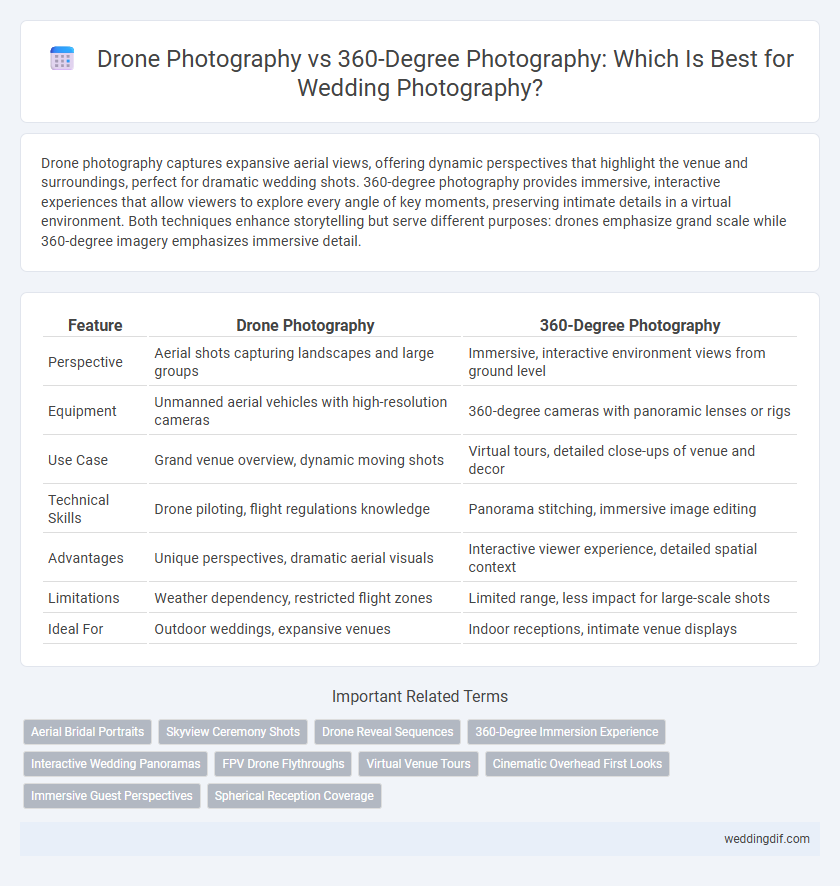Drone photography captures expansive aerial views, offering dynamic perspectives that highlight the venue and surroundings, perfect for dramatic wedding shots. 360-degree photography provides immersive, interactive experiences that allow viewers to explore every angle of key moments, preserving intimate details in a virtual environment. Both techniques enhance storytelling but serve different purposes: drones emphasize grand scale while 360-degree imagery emphasizes immersive detail.
Table of Comparison
| Feature | Drone Photography | 360-Degree Photography |
|---|---|---|
| Perspective | Aerial shots capturing landscapes and large groups | Immersive, interactive environment views from ground level |
| Equipment | Unmanned aerial vehicles with high-resolution cameras | 360-degree cameras with panoramic lenses or rigs |
| Use Case | Grand venue overview, dynamic moving shots | Virtual tours, detailed close-ups of venue and decor |
| Technical Skills | Drone piloting, flight regulations knowledge | Panorama stitching, immersive image editing |
| Advantages | Unique perspectives, dramatic aerial visuals | Interactive viewer experience, detailed spatial context |
| Limitations | Weather dependency, restricted flight zones | Limited range, less impact for large-scale shots |
| Ideal For | Outdoor weddings, expansive venues | Indoor receptions, intimate venue displays |
Introduction to Aerial and Immersive Wedding Photography
Drone photography offers dynamic aerial perspectives that capture expansive wedding venues and dramatic landscapes, creating visually stunning and unique shots. 360-degree photography provides an immersive experience, allowing viewers to explore every angle of the wedding environment, enhancing emotional engagement and virtual presence. Combining aerial drone shots with 360-degree imaging delivers comprehensive storytelling, blending broad vistas with interactive details for unforgettable wedding memories.
What Is Drone Photography in Weddings?
Drone photography in weddings captures dynamic aerial shots by utilizing unmanned aerial vehicles equipped with high-resolution cameras, providing expansive views and unique perspectives of the venue and guests. This technique allows for sweeping landscape images and cinematic motion, enhancing storytelling through dramatic angles inaccessible to traditional photography. Its ability to showcase outdoor settings and large gatherings from above makes it an ideal choice for couples seeking immersive and memorable wedding visuals.
Understanding 360-Degree Wedding Photography
360-degree wedding photography captures immersive, panoramic views that allow couples to relive every angle of their special day, providing a dynamic and interactive experience. Unlike drone photography, which focuses on aerial perspectives and dramatic overhead shots, 360-degree imaging offers a ground-level, all-encompassing visual narrative. This technique enhances storytelling by integrating every detail and guest interaction, making it ideal for capturing the emotional essence and environment of weddings.
Key Differences Between Drone and 360-Degree Photography
Drone photography captures expansive aerial views, offering dynamic perspectives of wedding venues and large group shots from elevated angles. In contrast, 360-degree photography provides an immersive, interactive experience by capturing panoramic scenes that allow viewers to explore every detail of the wedding environment. While drone shots emphasize dramatic overhead compositions, 360-degree images focus on comprehensive spatial storytelling and viewer engagement.
Visual Impact: Capturing Wedding Moments from Above vs. All Around
Drone photography captures sweeping aerial views that highlight the scale and setting of wedding venues, creating dramatic and memorable visuals from above. In contrast, 360-degree photography offers an immersive experience by enveloping viewers in every angle of the ceremony and reception, allowing a comprehensive view of emotions and details simultaneously. Combining drone and 360-degree techniques can provide a powerful storytelling approach, showcasing both expansive scenes and intimate moments in wedding coverage.
Venue Suitability: Outdoor vs. Indoor Wedding Spaces
Drone photography excels in capturing expansive outdoor wedding venues such as gardens, beaches, and large estates, offering sweeping aerial views that highlight the location's scale and natural beauty. In contrast, 360-degree photography is ideal for indoor wedding spaces like banquet halls and chapels, providing immersive, interactive perspectives that showcase intricate details and the venue's ambiance. Venue suitability depends on the spatial environment, with drones favored for open-air settings and 360-degree cameras optimized for enclosed, intimate spaces.
Technical Requirements and Equipment Comparison
Drone photography for weddings demands advanced UAVs equipped with high-resolution cameras, GPS stabilization, and obstacle avoidance systems to capture dynamic aerial shots with precision. In contrast, 360-degree photography relies on specialized panoramic camera rigs or multi-lens cameras that stitch images in real-time, requiring robust software and tripods for stable, immersive visuals. Both techniques necessitate skilled operators, but drone photography involves adherence to aviation regulations and battery management, while 360-degree photography hinges on seamless image blending and post-processing expertise.
Creative Possibilities for Unique Wedding Shots
Drone photography offers expansive aerial views that capture weddings from breathtaking perspectives, highlighting venue layouts and large group dynamics. 360-degree photography enables immersive, interactive experiences, allowing viewers to explore every angle of intimate moments and detailed decor. Combining both techniques maximizes creative possibilities, blending sweeping panoramas with complete scene interactivity for truly unique wedding shots.
Limitations and Challenges: Privacy, Regulations, and Logistics
Drone photography for weddings faces limitations including strict airspace regulations, potential privacy concerns due to aerial footage capturing unintended subjects, and logistical challenges like battery life and weather dependency. Conversely, 360-degree photography encounters fewer regulatory hurdles but struggles with privacy issues related to capturing guests in all directions and requires complex post-processing to ensure image clarity and guest comfort. Both methods demand careful planning to navigate legal restrictions and maintain respect for privacy while delivering immersive wedding visuals.
Choosing the Best Option for Your Wedding Photography Needs
Drone photography captures sweeping aerial views and dynamic movement, ideal for showcasing expansive wedding venues and outdoor ceremonies with high-resolution detail. 360-degree photography offers immersive, interactive images that allow couples and guests to explore every angle of the wedding environment, perfect for virtual tours and keeping memories alive in a unique way. Deciding between drone and 360-degree photography depends on your wedding location, desired storytelling style, and whether you prefer cinematic aerial shots or comprehensive, interactive visual experiences.
Drone photography vs 360-degree photography for wedding Infographic

 weddingdif.com
weddingdif.com